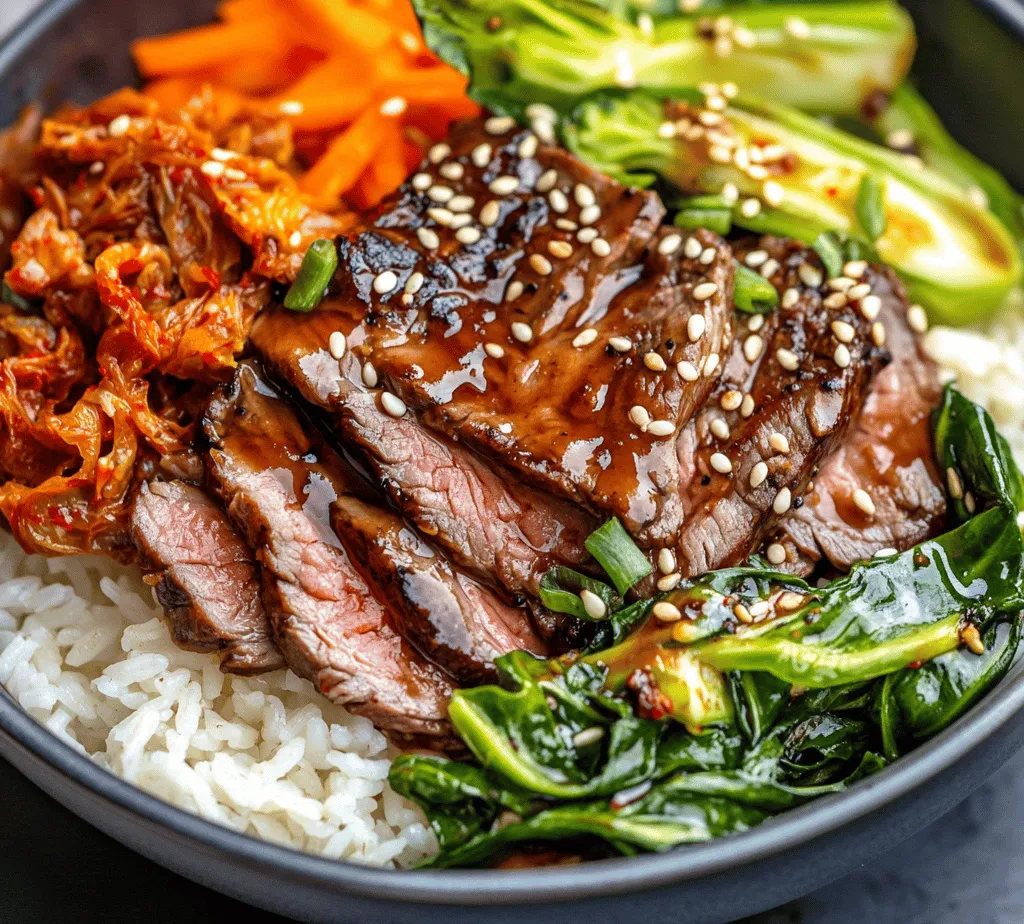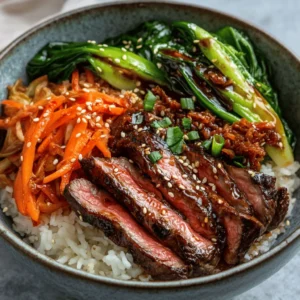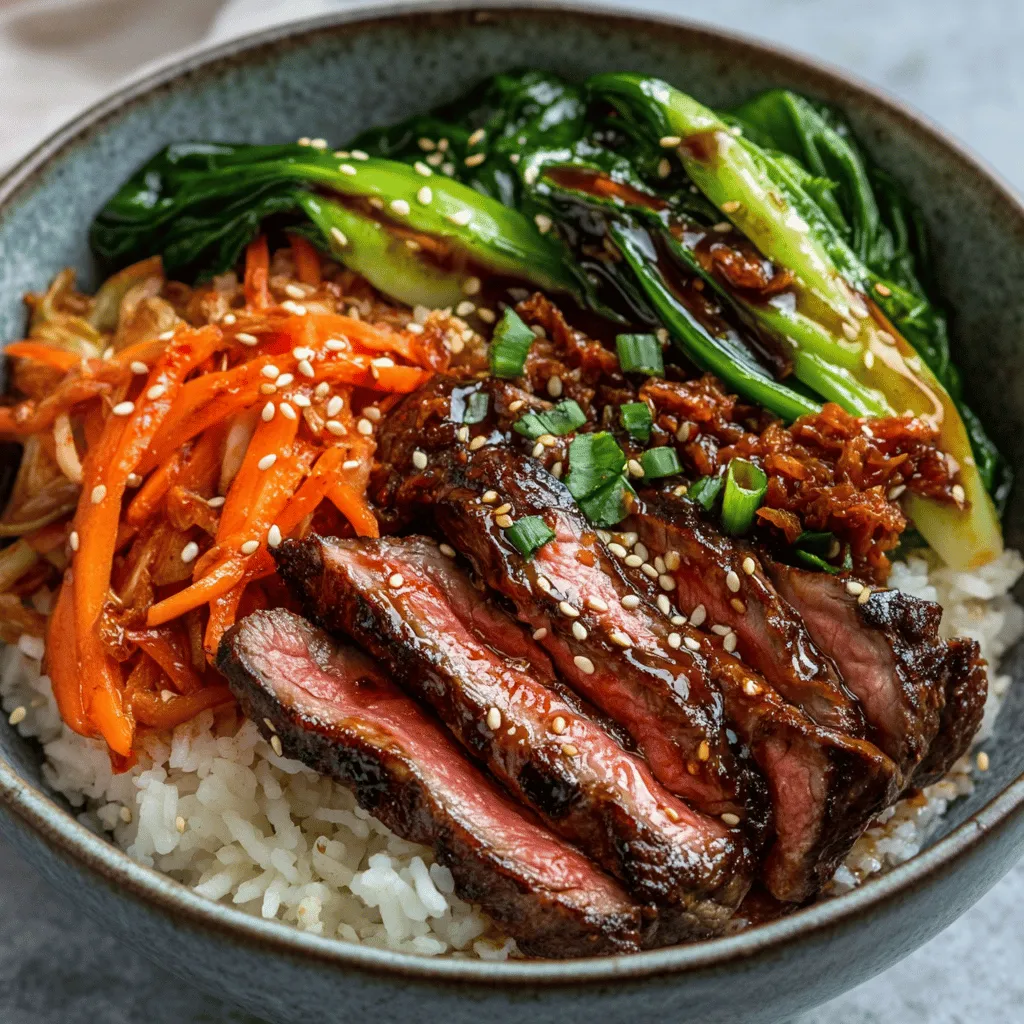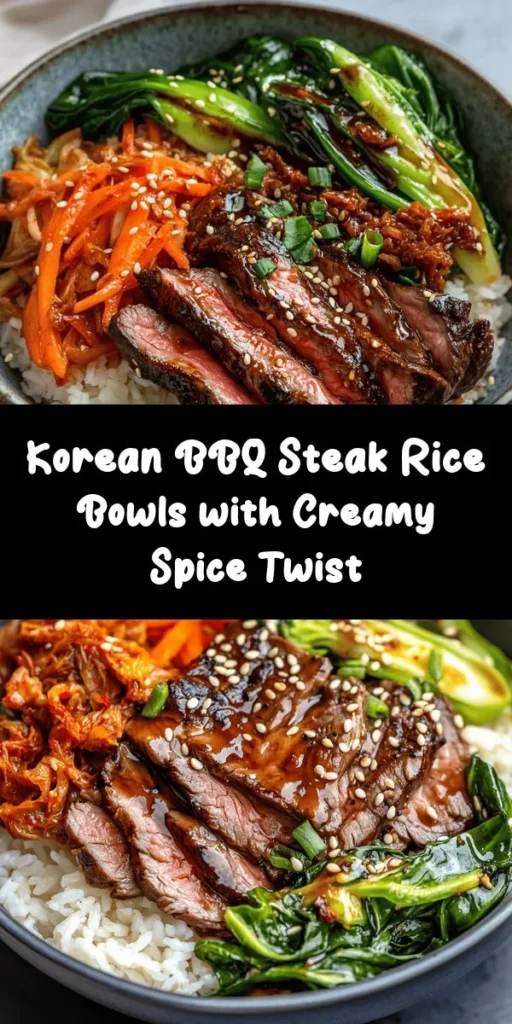Korean cuisine is renowned for its vibrant flavors, bold spices, and a unique balance of savory, sweet, and spicy elements. Among the myriad of dishes that showcase these characteristics, Korean BBQ stands out as a beloved favorite, captivating food enthusiasts around the globe. The interactive and communal experience of grilling marinated meats, often accompanied by an array of side dishes, is a culinary tradition that embodies the spirit of Korean culture. However, the beauty of Korean BBQ extends beyond restaurants; it has seamlessly found its way into home kitchens in the form of easy-to-make recipes that allow anyone to indulge in this delightful cuisine.
One such recipe is the Korean BBQ Steak Rice Bowls with Spicy Cream Sauce. This dish encapsulates the essence of Korean flavors while being approachable for home cooks of all skill levels. It combines tender marinated steak, fluffy rice, sautéed vegetables, and a luscious spicy cream sauce, creating a harmonious blend of textures and tastes that is sure to impress. The interplay of savory, spicy, and sweet notes makes this dish a standout, enticing readers to explore the world of Korean cooking right in their own kitchens.
In this article, we will delve into the key components of the Korean BBQ Steak Rice Bowls with Spicy Cream Sauce, providing a detailed guide that will make it easy for you to recreate this exciting dish at home. From understanding the core ingredients to mastering the marination and cooking processes, we will ensure you are well-equipped to enjoy this flavorful journey.
Understanding the Key Ingredients
To truly appreciate the depth of flavor in Korean BBQ Steak Rice Bowls, it’s essential to understand the key ingredients that contribute to this dish’s distinctive taste profile. Each element plays a vital role, harmonizing to create a satisfying and memorable meal.
The Steak Marinade
At the heart of this dish lies the marinated steak, and the marinade itself is a crucial component that elevates the meat’s flavor and tenderness.
– Soy Sauce and Sesame Oil: These two ingredients are staples in Korean cooking, providing a rich umami flavor that is both savory and complex. Soy sauce serves as the base of the marinade, infusing the meat with a deep, salty taste, while sesame oil adds a fragrant nuttiness that is characteristic of many Korean dishes.
– Garlic and Ginger: No Korean marinade would be complete without the aromatic duo of garlic and ginger. Garlic brings a robust flavor that permeates the steak, while ginger adds a subtle warmth and freshness, enhancing the overall taste experience.
– Brown Sugar: To achieve that perfect balance, brown sugar is added to the marinade. Its sweetness counteracts the saltiness of the soy sauce, creating a well-rounded flavor profile that makes each bite irresistible. The sugar also aids in caramelizing the meat during cooking, resulting in a delicious crust.
Highlighting the Rice Bowl Components
The foundation of any great rice bowl is, of course, the rice itself. In this recipe, we use jasmine rice, known for its fragrant aroma and slightly sticky texture, making it a perfect base for the flavorful toppings.
– Rice Varieties: Jasmine rice provides a light and fluffy base, while sticky rice, also known as glutinous rice, offers a chewier texture that some may prefer. Both types of rice can be prepared to complement the dish, so choose according to your preference.
– Kimchi and Sautéed Greens: Adding depth and nutritional value to the bowl, kimchi serves as a traditional side that brings a tangy crunch. Additionally, sautéed greens such as bok choy or spinach not only enhance the dish’s color but also contribute vital vitamins and minerals.
– Carrots and Green Onions: These ingredients are essential for both aesthetic appeal and texture. Shredded carrots add a pop of color and a slight sweetness, while green onions provide a fresh, oniony bite that brightens the overall taste.
Delving into the Spicy Cream Sauce
No Korean BBQ Steak Rice Bowl would be complete without the addition of a spicy cream sauce that ties all the flavors together.
– Gochujang: This fermented Korean chili paste is the star of the sauce, offering a unique flavor that is both spicy and slightly sweet. Gochujang adds depth and complexity, making the sauce a standout element of the dish.
– Creamy Texture: To balance the heat of the gochujang, mayonnaise is used to create a creamy sauce that complements the other ingredients. The richness of the mayonnaise helps to mellow the spice while adding a luxurious mouthfeel that elevates the dish.
Marinating the Steak: A Flavorful Foundation
Marinating the steak is a crucial step that sets the stage for a flavorful and tender meat experience. The process of marination not only enhances the taste of the steak but also helps in breaking down the proteins, resulting in a juicy and succulent bite.
– Enhancing Tenderness and Flavor: When marinated, the steak absorbs the flavors of the soy sauce, garlic, and ginger, infusing each bite with richness. The acidity from the marinade also helps to tenderize the meat, making it more enjoyable to eat.
– Marinating Time and Techniques: For optimal results, it is recommended to marinate the steak for at least 30 minutes, although longer periods—up to 24 hours—can yield even more intense flavors. It’s essential to cover the steak in the marinade and refrigerate it, allowing the flavors to meld while keeping the meat fresh.
– Choosing the Right Cut of Meat: Selecting the appropriate cut of meat is key to achieving the best marinated steak. Flank steak, sirloin, or ribeye are excellent choices, providing a great balance of flavor and tenderness. Look for cuts with some marbling, as the fat will contribute to the overall juiciness of the cooked steak.
Cooking the Rice: Creating the Perfect Base
The rice is the cornerstone of the Korean BBQ Steak Rice Bowl, serving as the perfect canvas for the flavorful toppings. Cooking the rice correctly is essential to ensure it complements the other ingredients.
– Jasmine vs. Sticky Rice: Jasmine rice is a popular choice for this dish due to its light and fluffy texture. It pairs well with the savory steak and the spicy cream sauce. On the other hand, sticky rice offers a chewier consistency, which some may prefer for a heartier bowl.
– Cooking Method: To cook jasmine rice, rinse it under cold water to remove excess starch, which helps prevent it from becoming gummy. Combine the rinsed rice with water in a pot (using a 1:1.5 rice-to-water ratio), bring to a boil, then cover and simmer on low heat for about 15-20 minutes until the water has absorbed. For sticky rice, soaking it in water for several hours before steaming is essential to achieve the desired texture.
Both types of rice create a satisfying base for your Korean BBQ Steak Rice Bowls, allowing you to customize the dish to your liking.
As we move forward, we’ll explore the process of assembling the bowls and creating that unforgettable spicy cream sauce that ties everything together, ensuring your culinary adventure into Korean cuisine is a success.

Step-by-Step Instructions for Cooking Perfect Rice
Cooking rice may seem straightforward, but achieving the perfect fluffy texture requires attention to detail. Follow these steps for rice that complements your Korean BBQ Steak Rice Bowls beautifully.
1. Measure Your Rice: Begin by measuring the appropriate amount of rice. A standard serving is about 1/4 to 1/2 cup of uncooked rice per person. For this recipe, 2 cups of jasmine rice is recommended, as its fragrant aroma pairs wonderfully with Korean flavors.
2. Rinse the Rice: Rinsing is crucial for removing excess starch that can lead to gummy rice. Place the rice in a fine-mesh sieve or bowl and rinse under cold water until the water runs clear. This process typically takes 1-2 minutes.
3. Soak the Rice (Optional): Soaking the rice for 20-30 minutes can enhance its texture, making it even fluffier. If you choose to soak, remember to drain it well afterward.
4. Cooking the Rice:
– In a medium saucepan, combine the rinsed rice with 2 1/2 cups of water (the ratio is generally 1 cup of rice to 1.25 cups of water for jasmine rice).
– Add a pinch of salt for flavor.
– Bring the mixture to a boil over medium-high heat.
5. Simmer: Once boiling, reduce the heat to low, cover the pot with a lid, and simmer for 15-20 minutes. Avoid lifting the lid during cooking, as this can release steam and affect the cooking process.
6. Let it Rest: After the cooking time, remove the pot from heat but keep it covered. Let the rice sit for another 10 minutes. This resting period allows the remaining steam to finish cooking the rice and improves the texture.
7. Fluff and Serve: Finally, use a fork to fluff the rice gently before serving. This helps to separate the grains and adds to the lightness.
Tips for Keeping Rice Warm
To keep your rice warm until serving, consider these practical tips:
– Use a Rice Cooker: If you have one, a rice cooker can keep rice warm for extended periods without overcooking it.
– Cover with a Towel: If you’re using a pot, covering it with a clean kitchen towel before putting the lid back on can help retain heat and moisture.
– Warm Oven: Preheat your oven to the lowest setting (around 200°F or 93°C) and place the covered pot inside to keep the rice warm without cooking it further.
Crafting the Spicy Cream Sauce: A Flavorful Accent
The spicy cream sauce is what elevates your Korean BBQ Steak Rice Bowls, providing a rich and zesty flavor. Here’s how to prepare it:
1. Ingredients: Start with the following ingredients:
– 1/2 cup sour cream
– 2 tablespoons mayonnaise
– 1 tablespoon gochujang (Korean red chili paste)
– 1 teaspoon soy sauce
– 1 teaspoon sesame oil
– 1 teaspoon lime juice (freshly squeezed)
– Optional: Sliced scallions or chopped cilantro for garnish
2. Combine Ingredients: In a bowl, mix the sour cream, mayonnaise, gochujang, soy sauce, sesame oil, and lime juice until smooth. This combination creates a creamy yet spicy base that complements the steak.
3. Adjusting Spice Levels: Taste the sauce and adjust the spiciness as needed. For a milder version, reduce the amount of gochujang, or add more sour cream to balance the heat.
4. Texture and Color: The sauce should be a vibrant red-orange color, creamy in texture, and smooth without lumps. If desired, add a touch of water or more sour cream to achieve your preferred consistency.
5. Variations: Experiment with the sauce by adding minced garlic, ginger, or even a splash of honey for sweetness. For a unique twist, consider substituting the sour cream with Greek yogurt for a tangy flavor boost.
Grilling the Steak: Achieving Perfect Doneness
Grilling the steak perfectly is key to a delicious Korean BBQ experience. Here’s how to ensure it turns out just right:
1. Preheat the Grill: Heat your grill to medium-high (about 400°F or 204°C). If using a charcoal grill, ensure the coals are fully lit and have ashed over.
2. Prepare the Steak: Remove the steak from the marinade (if using) and allow it to come to room temperature for about 30 minutes. Season it lightly with salt and pepper before grilling.
3. Grilling Process:
– Place the steak on the grill and cook for about 4-5 minutes per side for medium-rare, depending on the thickness of the cut. For a 1-inch thick steak, aim for an internal temperature of 130-135°F (54-57°C).
– Use tongs to flip the steak; avoid using a fork, as piercing can release juices.
4. Check for Doneness: Invest in a meat thermometer for accuracy. Here’s a quick guide for doneness levels:
– Rare: 120-125°F (49-52°C)
– Medium-rare: 130-135°F (54-57°C)
– Medium: 140-145°F (60-63°C)
– Medium-well: 150-155°F (65-68°C)
– Well-done: 160°F (71°C) and above
5. Resting Time: After grilling, let the steak rest for at least 5-10 minutes to allow the juices to redistribute. This step is crucial for ensuring a tender, juicy steak.
6. Slicing Against the Grain: When ready to serve, slice the steak against the grain. This technique shortens the muscle fibers, resulting in a more tender bite.
Assembling the Korean BBQ Steak Rice Bowls
Now that you have your rice, steak, and spicy cream sauce ready, it’s time to assemble your bowls.
1. Layering Technique: Start by placing a generous scoop of fluffy rice at the bottom of each bowl. This serves as the base for the other components.
2. Add the Steak: Next, arrange the sliced steak over the rice, ensuring it’s evenly distributed. The warm steak will slightly melt into the rice, enhancing the overall flavor.
3. Drizzle with Sauce: Generously drizzle the spicy cream sauce over the steak, allowing it to cascade down and infuse the rice with flavor.
4. Garnish for Flavor and Presentation: Top your bowls with garnishes like sesame seeds, sliced scallions, and fresh cilantro. These not only add visual appeal but also enhance the dish’s flavor profile.
5. Encourage Creativity: Feel free to add other toppings like pickled vegetables, shredded carrots, or avocado slices. This recipe is versatile, allowing personal preferences to shine through.
Serving Suggestions and Pairings
To enhance your dining experience, consider these complementary side dishes and beverage pairings:
1. Traditional Korean Side Dishes:
– Kimchi: A staple in Korean cuisine, its tangy, spicy flavor pairs perfectly with the richness of the steak.
– Banchan: Small side dishes like pickled radishes or seasoned greens add variety and balance to the meal.
– Japchae: Sweet potato noodles stir-fried with vegetables offer a delightful contrast to the rice bowls.
2. Beverage Pairings:
– Korean Beer: A crisp lager complements the bold flavors of the steak and sauce.
– Soju: This traditional Korean spirit can be enjoyed chilled and provides a refreshing contrast.
– Iced Green Tea: A non-alcoholic option that refreshes the palate between bites.
Conclusion
Korean BBQ Steak Rice Bowls with Spicy Cream Sauce offer a delightful taste of Korean cuisine that you can recreate at home. This dish is not just a meal; it’s an experience filled with flavor, color, and creativity. The combination of marinated steak, fluffy rice, and a zesty cream sauce creates a harmonious blend that is sure to impress family and friends.
As you gather around the table to share this vibrant dish, reflect on the joy that comes from cooking and enjoying meals together. These rice bowls celebrate culinary creativity, inviting you to customize and adapt the ingredients to your liking. So, roll up your sleeves, fire up the grill, and savor the delightful flavors of Korean BBQ right in your kitchen. Your taste buds—and your loved ones—will thank you.



